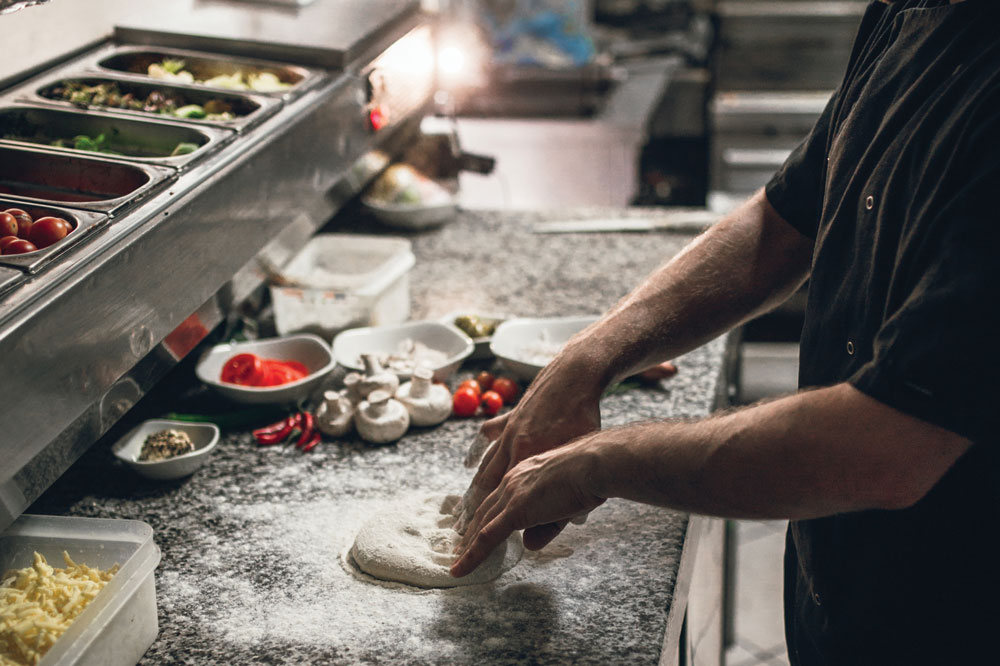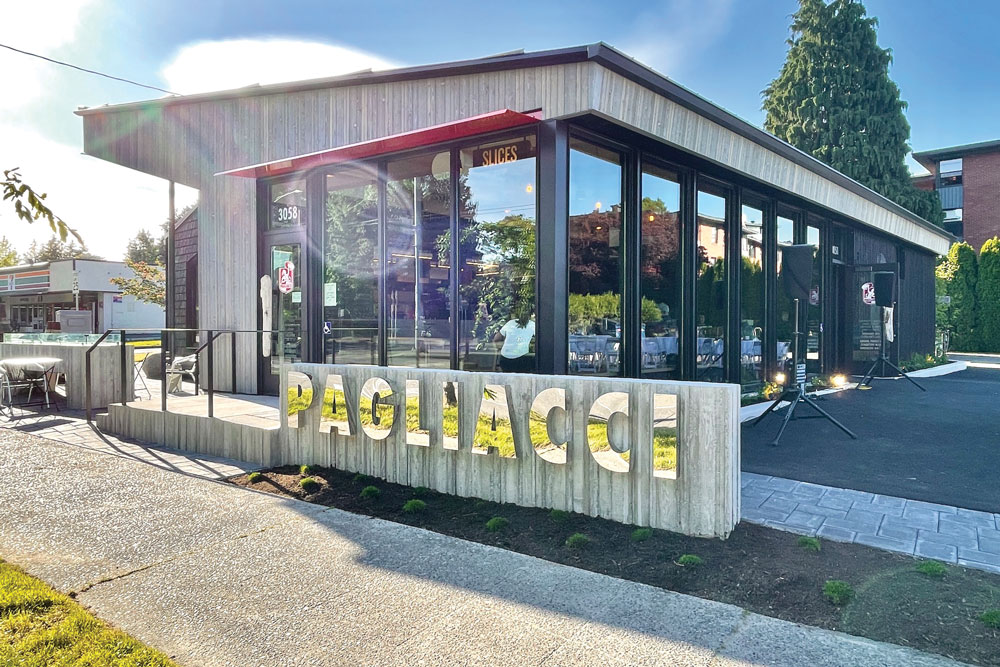Whether you’re planning an entire redesign or simply thinking of minor ways to boost your kitchen productivity, changes big and small can help ensure your operation is firing on all cylinders. “The goal in the foodservice kitchen is threefold,” explains Marc Tell, CEO of The Sam Tell Companies in Farmingdale, New York. “Provide a quality product to the customer; get the product out as quickly and correctly as possible; and minimize cost to the organization in terms of human resources.” Here, experts share how you can ensure maximum efficiency in the hub of your pizzeria—the kitchen—to meet these goals, and many more.
1 Think minimal.
As Tell outlines, when it comes to the kitchen, less is more: To provide a quality product in a timely manner, you want as few people as possible moving around as little as possible. “That means not taking too many steps to obtain or cook a product, or not needing to go back to walk-in coolers too often—in other words, employees need enough storage space, located nearby, so they needn’t keep restocking, and the space has to be efficient to handle as much of a shift as possible,” Tell says. “Design your kitchen to minimize manpower and maximize the usefulness of that manpower.”
Therefore, you’ll want to limit unnecessary movement and transportation—such as the number of steps taken per day and the amount of repetitive reaching, bending or lifting—according to Heather Larivee, CEO of Sparkflo in Milford, New Hampshire. When prep areas are smartly reconfigured, employees can spend less time walking or searching for things. “You’re eliminating waste from your system so you can deliver quality and add value for customers—but in this case, the customer is your employee,” Larivee explains. “You want them to spend less time walking around unnecessarily.”
2 Observe and diagram.
In order to minimize employee movement, maybe it’s better to move the prep area closer to where raw materials are stored or closer to the oven. But you won’t know unless you keep a close eye on the existing layout. “Observe the way people work around the kitchen,” Larivee says. “Are they constantly reaching up or bending down to get a tool, or walking back and forth to get supplies from the refrigeration? Understand the physical flow of the work and take out any unnecessary movement, because that ends up making the assembly process longer.”
Larivee explains that kitchen designers often use a tool called a spaghetti diagram—they simply draw out foot traffic on a piece of paper. “When studying an existing kitchen, it’ll often look like a mess of spaghetti, but it’ll help you analyze where motion is happening,” Larivee says. “If it’s a brand-new construction, that flow might look more like a clean triangle.” You can do the same by looking at the movement of hands, such as on a prep countertop. Where are the chef’s hands reaching, and where are they moving material to? You can then design your workspace around the movement required.

3 Sweat the small stuff.
When it comes to kitchen efficiency, even small tweaks can make a difference. For example, Tell stresses the importance of providing prep employees and cooks with ergonomic tools. “Tongs, ladles and other smallwares are typically overlooked, but, for instance, a locking tong stores easier and allows you to put more equipment in a given drawer,” he notes. “Wire whips can have rubber knots to prevent slipping or reduce forearm pain; spoons can have finger grips; or frying pans can have rubber handles to prevent burns.”
Also make sure equipment is functioning properly, Tell adds, and ensure you have a reliable manufacturer for major equipment, with nearby service providers in case something goes wrong. Make sure the electricity or gas supply is working properly and allow for appropriate venting and airflow for employees to work at their peak performance.
4 Involve employees.
Your employees live and breathe your kitchen setup every day, so it’s a good idea to solicit their opinions on any problems or barriers in the area. Larivee suggests encouraging them to think of better solutions or asking them to simply notice what they’re doing every day to help foster a spirit of continuous improvement. “The best ideas come from the people who do the work, so invest the time to understand the causes of kitchen inefficiencies and to develop and experiment with possible solutions,” Larivee recommends. “When employees are involved in solving problems, they develop a sense of ownership and will more likely be committed to continuous improvement efforts. And, when you make those changes, it’s easier to sustain them and subsequently make additional improvements, because employees are on board and engaged; they own it.”
Finally, when employees are part of the process, it helps build culture, improves morale and lets you create the best possible solutions for optimal workflow in each employee’s role.
“When employees are involved in solving problems, they develop a sense of ownership and will more likely be committed to continuous improvement efforts. And, when you make those changes, it’s easier to sustain them and subsequently make additional improvements.”
— Heather Larivee, Sparkflo
5 Measure results.
If you decide to make a change, measuring both before and after allows you to determine if it’s a positive step. “The only way to know if changes in your kitchen and prep process are beneficial is to measure, then compare those results to the desired outcome,” Larivee says. “If the changes don’t support the desired outcome, dig deeper to understand why, then go back to the drawing board and try again.”
This can be as simple as installing a whiteboard in the kitchen space and tracking a single change, Larivee explains. For example, before moving the prep area, measure something trackable, like the number of steps taken per day by an employee. Once you make the change, measure the steps taken afterward. “Maybe moving the prep area forces employees to walk around an obstacle and thus adds steps,” Larivee says. “It also depends on what problem you’re trying to solve. Ask yourself, what do we measure, what unit of measurement do we use, and how long of a period are we measuring for?”
For example, it might make sense to evaluate a few different shifts, as data will change according to number of people working and time of day. Or you might measure for a continuous period, like one or two weeks, to decide if a change is positive. And, if the results aren’t what you expected, you can always change something back!
6 Plan for growth.
Evaluating your kitchen’s efficiency isn’t a “one and done” deal. Just because a change is working well now, it might not remain the ideal setup forever. If the business doubles its volume or new menu items enter the mix, you may have to change your workflow. Even better, this practice of constant observation can help your business grow further. “Let’s say you add on a menu item and you’re tight on floor space,” Larivee says. “Studying the movement in the kitchen, related to each type of product made, helps you understand where you have dead space in your floor plan. If there’s a shelf in the corner that no one has visited in 30 days, maybe you can put a valuable piece of equipment in that space and better maximize your real estate.”
7 Customize your solutions.
Because every operation is different, Tell notes that a one-size-fits-all approach to commercial kitchens is impossible. “For a pizzeria with counter service, maybe you’d want the oven as close to the cash register as possible, especially when the same employee is working both,” Tell says. “In general, you want the prep table, oven and counter in a triangle. Or you might want employees to work in two shifts—prep and service—to increase efficiency and help product get out quicker, in a less complicated way, for both staff and customers.”
Tell adds that you can utilize a professional to help design your space and improve kitchen productivity with useful tips, like maximizing energy efficiency through equipment selection. And, he notes, many design professionals will work for free, as long as they make a sale. However, when choosing a professional, Tell advises, ask plenty of questions. Look at the company resume, call their references, and ask about aftermarket service to find the best match for your needs.
Tracy Morin is PMQ’s senior copy editor.















